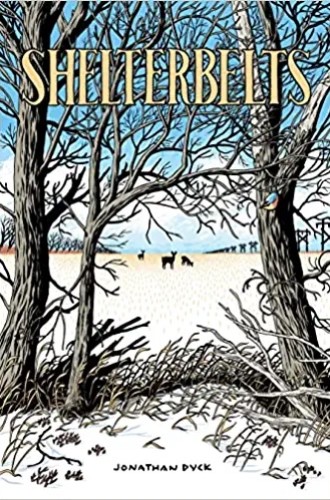Jonathan Dyck’s queer Mennonite graphic novel
Shelterbelts is a quiet ode to rural life that honors what is good and confronts what is not.
Discussing religion and humanity in an interview with Conundrum magazine, author and illustrator Jonathan Dyck describes faith as a practice and an orientation. While recognizing that it can be prescriptive and personal for some, Dyck approaches faith not as a possession to be lost or found but rather as something collectively lived. Faith can occur not only through religious devotion but “as a response to one’s circumstances . . . in one’s political commitments, in the refusal to accept things as they are and remain open to alternative possibilities.”
With this expansive spirit, Dyck’s debut long-form graphic novel, Shelterbelts, illuminates the faithful practices and queries of a rural Mennonite community in Manitoba as its members grapple with their histories, their identities, and their varied responses to shifts within and around them. Churches shrink and swell; queer young people find their way; farmers, landowners, and land protectors grapple with past and future; teachers and activists confront the encroaching presence of military recruits and oil lords. Dyck’s compelling story lines and captivating graphics reflect the sincerity, curiosity, and intimacy he brings to his work, clearly respecting faith as a guiding orientation even as he critiques and plays with it. Shelterbelts invites readers of many perspectives to do the same.
Read our latest issue or browse back issues.
It would not be inaccurate to call Shelterbelts a queer Mennonite graphic novel, perhaps the first of quite this kind. Queerness is a theme woven throughout, most obviously as an identity of several characters and topic of church conversation and conflict. But I suggest that this book functions to queer—to disrupt or unsettle—presumed categories in several additional ways.
First, structured as a series of separate yet interconnected vignettes, Shelterbelts queers, or complicates, linear narrative. Each story introduces new and overlapping characters and raises questions—often unanswered—even as meaningful momentum builds.
This text also queers seemingly rigid binaries such as rural/urban, church/world, tradition/change, belonging/nonbelonging, and staying/leaving. As a queer White Mennonite from a fifth-generation Illinois farm who has lived most of my adult life in US cities, I found that page after page reflected my own experience navigating these binaries and the spectrums they span. Shelterbelts portrays multiplicity among Mennonites and rural people broadly. This kind of nuance is too often overlooked or dismissed.
The title invokes nuance as well. As Dyck says, shelterbelts—tree lines planted as windbreaks to protect fields—“suggest and signify many things at once.” They serve as a practical source of protection and aid for the farmers and crops around them. At the same time, their grid-like presence is a direct result of agriculture’s impact on the surrounding environment, an impact taken up in the book’s form as well.
Stylistically, Dyck sticks with a square panel grid that can be divided in up to four parts, mimicking how gridded farmland is parceled into sections and quarter sections. “The invisible architecture might not be immediately obvious to readers,” he said in a recent interview for Publishers Weekly, “but that’s the way it is with landscape. You don’t notice things when you’re inside of them.”
Just as agriculture has enabled the survival and livelihood of Mennonite settlers, these repatterned landscapes have destroyed entire ecosystems: tallgrass prairies and the vibrant life they once fostered. Leaning into this tension, Dyck envisions each vignette in this book as a kind of shelterbelt on the land.
Resisting heavy-handedness or caricature, Dyck rejects stereotypes and oversimplifications of Mennonites and rural folk as backward, problematic, old-fashioned, and small-minded. He also rejects oversimplified images Mennonites may have of themselves as homogenous, blameless, and set apart. Admittedly, Shelterbelts thoroughly evokes (and perhaps humbly celebrates) the European-descended Mennonite milieu through the songs, food, linguistics, worship, geographies, and historical references that appear in these stories. Dyck’s attention to cultural cues register both the familiarity and diversity therein. And his details are delightful: from the titles on the bookshelf to the scriptural cross-stitch on the wall to the tiny Mennonite Central Committee logo on the guitar, a Mennonite aesthetic cannot be mistaken.
Yet Dyck does not shy away from issues and realities that warrant reckoning. Shelterbelts pushes back, truthfully and compassionately, against Mennonite exceptionalism. It also engages the entanglements of settler colonialism, migration, missions, conscientious objection and rejection, ancestral harm, generational shame, biblical interpretation, capitalism, evangelism, progressivism, and the fracturing of church and family.
Some may wonder if this is too big a load to tackle in a single novel. However, a strength of this book is how it reveals—with respect, lament, and humor—the connections among pressing concerns that are particular though not unique to Mennonites. Dyck does this most effectively through his characters. He shines as a writer and artist through their subtle evolutions; characters’ questions and explorations draw the reader in. Their full humanity is glimpsed as they try to respond faithfully and meaningfully to injustice and inconsistency. Flaws, pain, and contradiction are held amidst integrity, conviction, tradition, and transformation. Characters are affirmed as they wrestle and fail, and the reader wrestles alongside them.
Shelterbelts is a quiet ode to rural Mennonite life that feels right—not because it is praise, but because it is honest. Dyck’s novel is a mirror and a prism, a provocation and a balm. It honors what is good, and it confronts what is not. This book bears witness to a profound yet ordinary hospitality toward the neighbor, to the kind of social fabric and relational economy found in less populated places. It bears witness to the complexity of such places, too—and to their fragility. Loss and change, including of faith itself, are intertwined with resilience, and Dyck shows how adaptation, even out of necessity, can be liberative. Shelterbelts beckons readers to find themselves in its story—and to find their neighbors, sometimes surprisingly so.
Dyck’s final image, tender and striking (as his single-page drawings are throughout), leaves Shelterbelts beautiful and unresolved. I found myself wanting a sequel, to keep journeying with these characters and their community. But perhaps the untidy ending of these stories and of this people is better akin to the faith they portray, and a rather queer faith at that. Faith as an orientation, as a practice, as communal response—the kind of faith that helps people chart their way through disruption, dissonance, and reckoning, toward uncertain and generative possibility.






